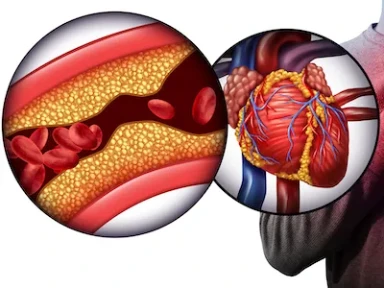{
event: "article_read",
name: `Lipid-Lowering Therapy and Achievement of Lipid Targets ESC and EAS Guidelines`,
author: ``,
tags: `Dyslipidemia`,
publication_date: ``,
interaction_type: "content"
}
Lipid-Lowering Therapy and Achievement of Lipid Targets ESC and EAS Guidelines
Lipid-lowering therapy and achievement of prior and new European guideline-recommended lipid targets in post-percutaneous coronary intervention patients: Observational nationwide cohort study
This retrospective, observational, population study suggests low rate of achievement of the new European Society of Cardiology (ESC)/European Atherosclerosis Society (EAS) lipid targets in post-percutaneous coronary intervention (PCI) population and relatively low rates of prescribing intensive lipid-lowering therapy (LLT) in individuals with uncontrolled lipids.
Key Takeaway
- Relatively low rate of high-intensity statin (HI statin) prescription ± additional evidence-based LLT agents in a large post-PCI patient population was noted, with a low proportion achieving the 2019 EAS/ESC lipid target.
- As per 2016 ESC/EAS guidelines, non-high-density lipoprotein cholesterol (non-HDL-C) and low-density lipoprotein cholesterol (LDL-C) targets (<1.8 mmol/l) were achieved in 57% and 48% patients, respectively; as per 2019 guidelines, target (<1.4 mmol/l) was attained in only 37% and 23% of patients, respectively.
- 6% of patients undergoing PCI within 2 years of a prior admission for an ACS achieved the new target of <1.0 mmol/l.
- There is considerable potential for LLT optimization through statin intensification and appropriate use of novel LLT, which would be expected to improve clinical outcomes at individual and population levels, especially in women.
- Nevertheless, the economic impact of novel management strategies and potential value to healthcare providers and funders requires careful planning and evaluation.
Why This Matters
- The data and treatment of patients with very high cardiovascular disease (CVD) risk who achieve or fail recommended (ESC/EAS) LDL-C (non-HDL-C) and/or triglyceride (TG) levels are limited.
- A better understanding of these relationships will help characterize the therapeutic gap, as well as the potential opportunity to optimize CVD risk management at individual and population levels.
- This study aimed to document (a) LLT and (b) achievement of prior and current ESC/EAS lipid targets in a contemporary national cohort of post-PCI patients.
Study Design
- This was a retrospective, observational cohort study using anonymized electronic health record data of patients undergoing PCI (January 2012–December 2017) in Wales, UK.
- Inclusion criteria: age ≥18 years; ≥90 days of follow-up
- Date of the first PCI (index date) during the study period for each patient with follow-up for 1 year was recorded.
- Time to the first lipid profile and the lowest LDL-C, non-HDL-C, and TG levels between 28–365 days post-discharge were documented.
- Prescriptions were identified during follow-up for LLTs, including statins, ezetimibe, fibrates, and prescription-grade N-3.
- Study evaluated the number and proportion of patients achieving:
- LDL-C < or ≥: 1.4 and 1.8 mmol/l; non-HDL-C < or ≥: 2.2 and 2.6 mmol/l; TG < or ≥: 1.5 and 2.3 mmol/l; and their respective LLT regimens
- LDL-C < or ≥1.0 mmol/l and non-HDL-C < or ≥1.8 mmol/l and their respective LLT regimens; index PCI was a recurrent event within 2 years of a prior event
Key Results
- In total, 15,203 patients met the study inclusion criteria, of which 11,048 (72.7%) patients had a lipid profile documented within the study period.
- Overall, 10,071 of 11,048 patients had an LDL-C documented between 28 days and 1 year (mean [SD] lowest LDL-C = 1.90 [0.79] mmol/l).
- 4,812 (47.8%) achieved LDL-C levels below the 2016 EAS/ESC target (<1.8 mmol/l); only 2,353 (23.4%) patients were below the 2019 target (<1.4 mmol/l).
- Of 15,023 patients, 1,020 (6.7%) had experienced an atherosclerotic event within 2 years before the index PCI, of which 627 patients had a documented LDL-C during the study period. Of these, only 33 (5.3%) patients had LDL-C levels below the 2019 target (<1.0 mmol/l).
- Of the patients with recurrent events within 2 years and LDL-C ≥1.0 mmol (n = 594), 52.5% (n = 312) were prescribed HI statins, 36.0% (n = 214) were prescribed standard-intensity statins, 3.1% (n = 19) were prescribed ezetimibe and/or a fibrate in addition to a statin, 2.0% (n = 12) were prescribed either ezetimibe and/or fibrate without a statin, and 6.2% (n = 37) had no LLT prescription.
- Considering patients with documented LDL-C >1.8 mmol/l and 1.4 mmol/l, 2,437 and 4,082 patients, respectively, were prescribed HI statins; only 117 and 146 were prescribed a combination of ezetimibe and/or fibrate plus a statin, with 103 and 109 prescribed ezetimibe and/or fibrate without a statin, respectively.
- Of the 5,340 patients with non-HDL-C levels documented (mean [SD] lowest non-HDL-C = 2.6 [0.97] mmol/l), 42.8% (n = 2,286) had non-HDL-C ≥2.6 mmol/l and 63.0% (n = 3,366) had ≥2.2 mmol; 314 patients had recurrent atherosclerotic events, of whom 12.7% (n = 40) were below the threshold of 1.8 mmol/l.
- Overall, 10,592 patients had TG levels recorded between 28 days and 1 year (mean [SD] lowest TG = 1.54 [1.01] mmol/l); of these, 14.4% (n = 1,524) had TG ≥2.3 mmol/l and 40.7% (n = 4,314) had TG ≥1.5 mmol/l.
Limitations
- The study failed to identify the quantity of medication prescribed.
- No patients with PCSK9 inhibitor prescription were identified in the study dataset.
- Lipid profiles recorded during the index admission were unavailable; moreover, these were not documented for over 25% of patients.
- Acute peripheral vascular events were not included.
- Langer A, Mancini GBJ, Tan M, Goodman SG, Ahooja V, Grégoire J, et al. Treatment inertia in patients with familial hypercholesterolemia. J Am Heart Assoc. 2021;10(14):e020126. doi: 10.1161/JAHA.120.020126. PMID:
Related articles
MAT-KW-2200113/V3/JAN2024


.webp/jcr:content/Lipid-lowering-therapy-thumb%20(2).webp)
.webp/jcr:content/Evaluation-of-lipid-management-following-ACS-thumb%20(1).webp)
